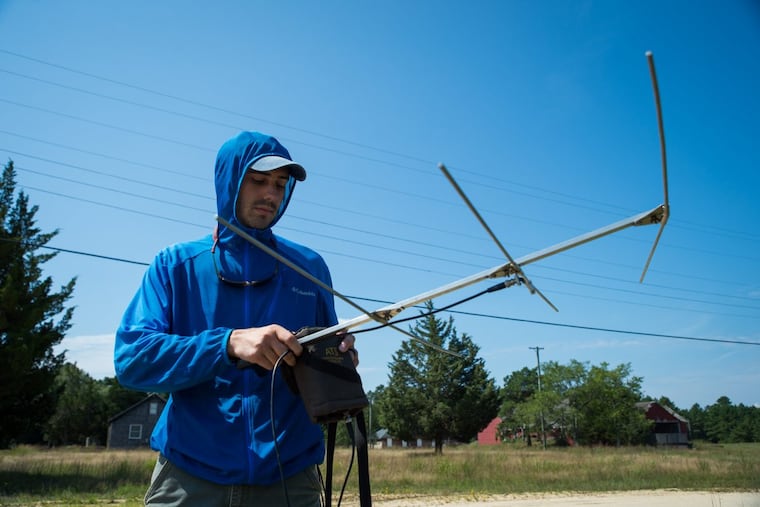Bringing back a bird that once made a signature sound of the Pine Barrens
After three years, wild quail from Georgia appear to be doing well in South Jersey, making nests, hatching eggs and raising chicks.

Holly Haines grew up on her family's Burlington County cranberry farm hearing Northern Bobwhite quail calling to each other.
That distinctive bob–WHITE and the beautiful birds who make it virtually disappeared from New Jersey decades ago.
But since 2015, 120 nesting pairs have been transported from Georgia to the Haines family's Pine Island Cranberry Co., a 14,000-acre property near Chatsworth, where the vulnerable, short-lived, but prolific quail are being released, monitored, and studied.
In three years, 39 nests — the earliest of which marked the first wild quail nesting in New Jersey since the 1980s — have been made; of the dozen this year, six have been decimated by predators, five were successful, and one is still active.
"If all the [50] chicks that hatched this year are alive, there would be about 85 to 90 birds on site right now," said John P. Parke, stewardship project manager for the NJ Audubon Bobwhite Quail Restoration Project, which he described as part of a "multi-state initiative to evaluate different options for restoring bobwhite populations in the mid-Atlantic region."
Other partners in the effort include Tall Timbers, a respected forestry management organization in Florida that's a national leader in quail restoration, and the New Jersey Division of Fish and Wildlife.
Beloved by birders and hunters alike, bobwhites nest and raise their young on the ground, preferring habitats where fields and forests are in proximity. The birds have become functionally extinct in New Jersey, Pennsylvania and many other states, although Delaware still has a small indigenous population.
"Bobwhites have tanked nationally mostly due to habitat changes, including loss to development," Parke noted, adding that "improved fire suppression, and changes in timber management" also have helped create "forests that are all the same age" that offer fewer quail-friendly amenities, such as the ground-level insects protein-hungry chicks need to eat.
To see the project for myself, I recently accompanied Parke, Haines, her niece Stefanie Haines, and intern Omar Lamrabat, 21, a senior at Rutgers University in New Brunswick, into a field study area near Hogwallow. That's the evocative name for the scenic sea of Haines family cranberry bogs and piney woodlands made famous by John McPhee's landmark book, The Pine Barrens.
The 20-minute trip from Pine Island's picturesque headquarters on Route 563 followed a mostly unmarked labyrinth of paved and sand roads. We passed a succession of alternately lush and stark landscapes that were veined with streams of dark water and opened into blue vistas of lakes and bogs.
"There are three broods on the ground right now." said Phil Coppola, a research assistant who was waiting for us in an open field of tall grass that was bordered by woods. Nearby, clusters of rare orchids and pitcher plants flourished in the humid air.
"Most of the birds are doing everything right," added Coppola, for whom the research is part of his dissertation project at the University of Delaware. "They're surviving after translocation, and they're making nests. And we're getting excellent data."
Coppola carried a radio telemetry antenna and a receiver that picked up signals from nearby adult birds that have been banded and collared with battery powered transmitters.
Suddenly a pair of quail rocketed up and out of the grass and soared skyward in a majestic flash of sound and feathers.
"You just got to see something a lot of people haven't seen in years," said Parke, describing the airborne pair as among "the only true wild quail we know of in the state right now."
The Haines family has grown cranberries in Burlington County for generations; its holdings have been so well-managed that the Pine Island farm is proving to be an excellent site for the quail project.
"A quality habitat was in place already," Parke said. "This place is phenomenal for seeing the most amazing wildlife, the most amazing plant life."
The state's Northern Bobwhite Quail Action Plan described the Pine Barrens, and Cumberland County, as areas of New Jersey with sizable potential habitats best suited for re-introduction of the birds. The presence of large landowners such Pine Island and other cranberry growers with large parcels nearby made the Pinelands a better choice, Parke says.
Holly Haines is the president of the Haines Family Foundation, which has supported the project from the beginning.
"This is probably the largest environment-related project we've done," said Haines, who, like her niece, sees restoring the bobwhite as complementary to their family's tradition of strong stewardship.
"My grandfather [the late William Haines Sr.] always told my dad and my aunt that 'we take care of the water, we take care of the woods, and we take care of our business,'" Stefanie Haines said. "It means we're doing the right thing."
This is the first year that the transplanted quail have "double-clutched," or laid more than a single nest of eggs. And birds released last year have mated with newer arrivals.
Both of these events are encouraging. But even with their high fertility, Parke cautioned that bobwhites — and their signature bob-WHITE — aren't likely to be common in and around Hogwallow any time soon. Research papers to be published and peer reviewed next year should help determine whether translocation is the preferred method of bringing back the birds.
"Growing up, you don't even realize something that's so much a part of where you live isn't there anymore," Holly Haines said.
Later, "you miss those things," she added. "For people who live around here, the sound of the bobwhites was natural. I hope it will be part of our lives again."